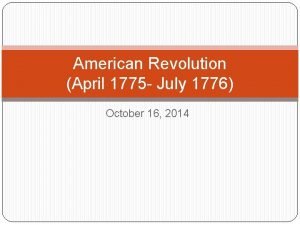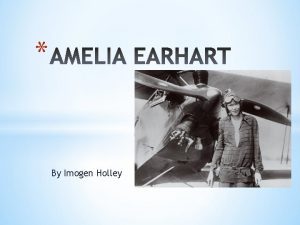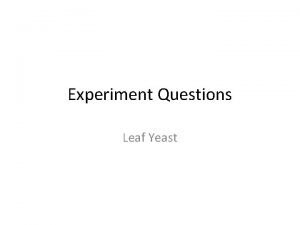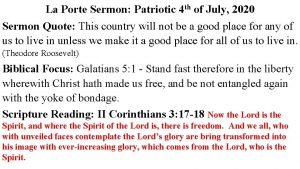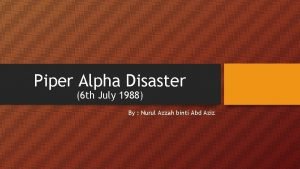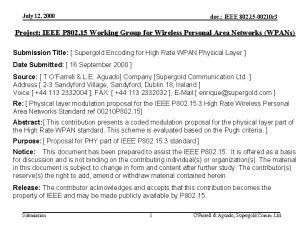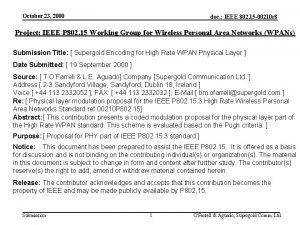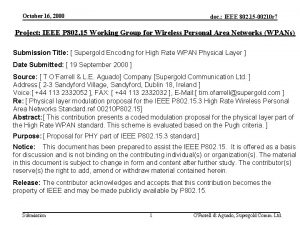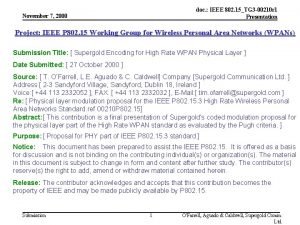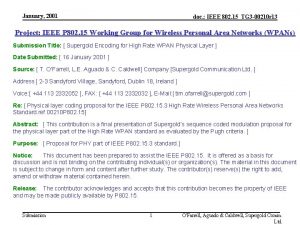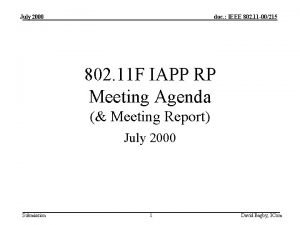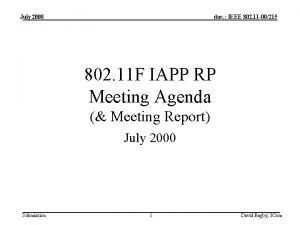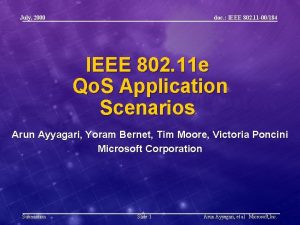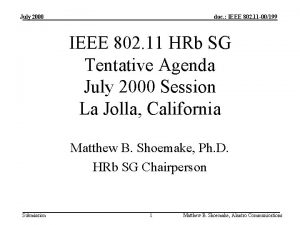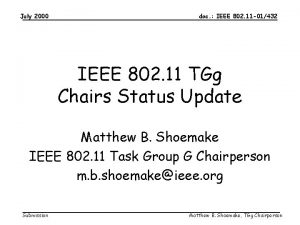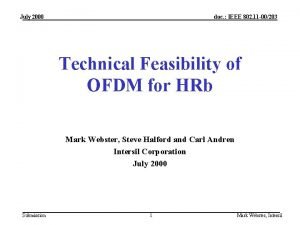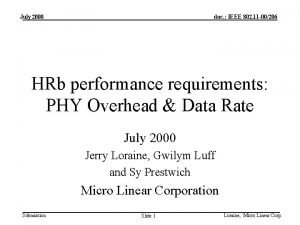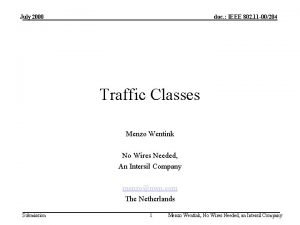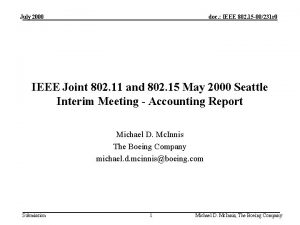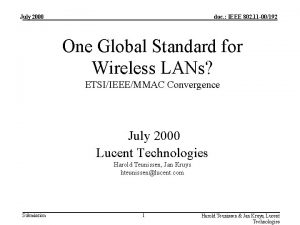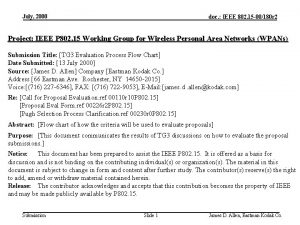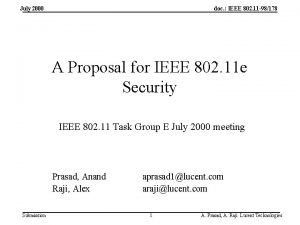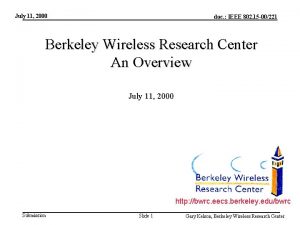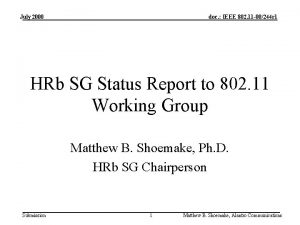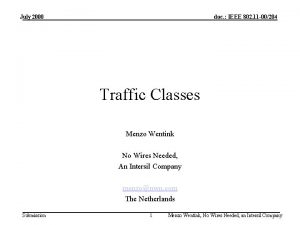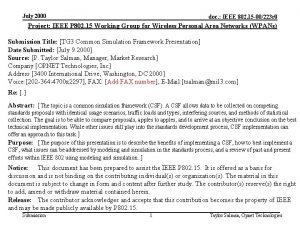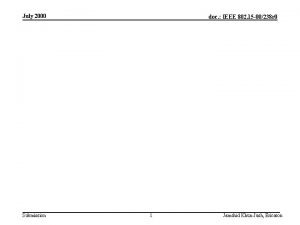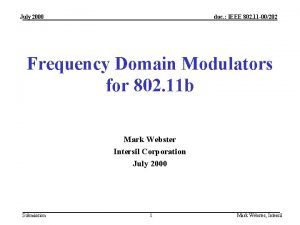July 12 2000 doc IEEE 802 15 00210




































- Slides: 36

July 12, 2000 doc. : IEEE 802. 15 -00210 r 5 Project: IEEE P 802. 15 Working Group for Wireless Personal Area Networks (WPANs) Submission Title: [ Supergold Encoding for High Rate WPAN Physical Layer ] Date Submitted: [ 19 September 2000 ] Source: [ T O’Farrell & L. E. Aguado] Company [Supergold Communication Ltd. ] Address [ 2 -3 Sandyford Village, Sandyford, Dublin 18, Ireland ] Voice: [ +44 113 2332004 ], FAX: [ +44 113 2332032 ], E-Mail: [ enrique@supergold. com ] Re: [ Physical layer modulation proposal for the IEEE P 802. 15. 3 High Rate Wireless Personal Area Networks Standard. ref 00210 P 802. 15] Abstract: [ This contribution presents a coded modulation proposal for the physical layer part of the High Rate WPAN standard. This scheme is evaluated based on the Pugh criteria. ] Purpose: [ Proposal for PHY part of IEEE P 802. 15. 3 standard. ] Notice: This document has been prepared to assist the IEEE P 802. 15. It is offered as a basis for discussion and is not binding on the contributing individual(s) or organization(s). The material in this document is subject to change in form and content after further study. The contributor(s) reserve(s) the right to add, amend or withdraw material contained herein. Release: The contributor acknowledges and accepts that this contribution becomes the property of IEEE and may be made publicly available by P 802. 15. Submission 1 O'Farrell & Aguado, Supergold Comm. Ltd.

July 12, 2000 doc. : IEEE 802. 15 -00210 r 5 Supergold Communication • Supergold Communication is a campus start up company that specialises in solutions for wireless communications: – Sequence Coded Modulation – Sequence/Code Design – Synchronisation • By efficiently exploiting the distance properties of sequences/codes, Supergold’s solutions balance the trade-off between bandwidth efficiency, BER performance and complexity. • Supergold’s solutions can be beneficially applied in – – Submission WPAN WLAN Wireless Infrared Cellular Mobile 2 O'Farrell & Aguado, Supergold Comm. Ltd.

July 12, 2000 doc. : IEEE 802. 15 -00210 r 5 Sequence Coded Modulation for High Rate WPAN PHY • M-ary symbol modulation — QPSK / OQPSK chip modulation – constant amplitude – no PA back-off, low power consumption – robust in multipath fading up to 30 ns rms delay spread • Single-error-correcting concatenated RS(127, 125) code – RS code matched to M-ary modulation – very simple Berlekamp-Massey hard-decision decoding – very high rate (0. 98) • > 3 d. B coding gain over QPSK @ 10 -6 BER • High spectral efficiency: 22 Mbit/s data rate in 22 MHz Submission 3 O'Farrell & Aguado, Supergold Comm. Ltd.

July 12, 2000 doc. : IEEE 802. 15 -00210 r 5 Properties of the sequence coded modulation (cont. ) • Based on pre-existing technology – Feasible solution – Short Development time – Dual mode 802. 15. 1 / 802. 15. 3 using common RF blocks • Works in the 2. 4 GHz ISM band with 802. 11 channelisation – Cost effective – Allows for 802. 11 b - 802. 15. 1 and 802. 15. 3 co-existence – Can operate in 5 GHz band • Very low baseband complexity • CCA as in 802. 11 b Submission 4 O'Farrell & Aguado, Supergold Comm. Ltd.

July 12, 2000 doc. : IEEE 802. 15 -00210 r 5 Example of Link Budget for Two-Ray Model [based on: IEEE 802. 15 -00/050 r 1, Rick Roberts] Rx Noise Figure: 15 d. B (inexpensive implementation) Rx Noise Bandwidth: 22 MHz Rx Noise Floor: -174+10*log(22*106)+15 = -85. 6 d. Bm Implementation Loss Margin: 5 d. B Antenna Gain: 0 d. B Submission 5 O'Farrell & Aguado, Supergold Comm. Ltd.

July 12, 2000 doc. : IEEE 802. 15 -00210 r 5 Example of Link Budget for Two-Ray Model (Cont. ) Maximum Second Ray Delay: 25 ns Maximum Second Ray Refflection Coefficient: -6 d. B Required Direct Ray Range: 10 m Loss Equation (d. B): L = 32. 5+20 log(dmeters)+20 log(FGHz) At 2. 4 GHz, assuming the direct ray is blocked, the loss of the reflected ray path (17. 4 m) is: L = 32. 5+24. 8+7. 6+6 = 70. 9 d. B (6 d. B reflection coefficient) Including antenna gain and implementation loss: Total Loss Budget: L + 2*0 + 5 = 75. 9 d. B Operating SNR is 10 d. B for 10 -6 BER Tx Power: Noise Floor + SNR + Loss = -85. 6 d. Bm + 10 d. B + 75. 9 d. B Tx Power 0 d. Bm Submission 6 O'Farrell & Aguado, Supergold Comm. Ltd.

July 12, 2000 doc. : IEEE 802. 15 -00210 r 5 PHY Block Diagram Baseband Processing RF IF Frequency Synthesiser Submission 7 O'Farrell & Aguado, Supergold Comm. Ltd.

July 12, 2000 doc. : IEEE 802. 15 -00210 r 5 Baseband Processor — M-ary Sequence coded modem DATA IN Rx I IN Rx Q IN r. I r. Q Submission d 1 c Select 1 of 128 Sequences 8 x. Q 8 I OUT Q OUT 8 1 1 RS Encoder 7 x. I Fast Transform Correlator 8 Maximum Likelyhood Detector 8 c’ 7 RS Decoder y 1 DATA OUT O'Farrell & Aguado, Supergold Comm. Ltd.

July 12, 2000 doc. : IEEE 802. 15 -00210 r 5 • RF Functionality – All RF blocks shared between 802. 15. 1 and 802. 15. 3 modes. No blocks repeated. – Transmit power = 0 d. Bm – RFPA efficiency of 33%, No RFPA back-off – CMOS technology • BB Functionality – – – – Fast transform correlators - 12. 5 Mchips/s rate 3 -bit Rx ADCs - 50 Msample/s rate 6 -bit Tx DACs - 50 Msample/s rate 6 -bit AGC ADC 16 -tap digital raised-cosine pulse shaping filter 30 K gates for BB processing 0. 18 u CMOS process in a dedicated ASIC • 1 chip implementation, 1 crystal, 2 filters (front-end, SAW IF) Submission 9 O'Farrell & Aguado, Supergold Comm. Ltd.

July 12, 2000 doc. : IEEE 802. 15 -00210 r 5 Characteristic of pulse shape digital raised-cosine filter Submission 10 O'Farrell & Aguado, Supergold Comm. Ltd.

July 12, 2000 doc. : IEEE 802. 15 -00210 r 5 General Solution Criteria 2. 1. Unit Manufacturing Cost Similar to 802. 15. 1 equivalent UMC at 2 H 2000 – Similar architecture to IEEE 802. 11 b – Much simpler baseband processing than 802. 11 b (30 K gates) – Low power PA (0 d. Bm Tx Power) – Shared RF architecture for 802. 15. 1 and 802. 15. 3 modes – 1 Chip RF / BB implementation Submission 11 O'Farrell & Aguado, Supergold Comm. Ltd.

July 12, 2000 doc. : IEEE 802. 15 -00210 r 5 General Solution Criteria 2. 2. Signal Robustness 2. 2. 2. Interference and Susceptibility – BER criterion = 10 -3 3 d. B loss of required sensitivity for: • J/S (MAI) = -6 d. B co-channel • J/S (CW) = -7 d. B co-channel – Adjacent+1 channel power atenuation > 50 d. Bc min. In-band interference protection > 40 d. Bc – Out-of-band attenuation > 80 d. Bc Complies with BT 1. 0 b out-of-band blocking Submission 12 O'Farrell & Aguado, Supergold Comm. Ltd.

July 12, 2000 doc. : IEEE 802. 15 -00210 r 5 General Solution Criteria 2. 2. 2. Interference and Susceptibility (cont. ) System performance in the presence of interference Submission 13 O'Farrell & Aguado, Supergold Comm. Ltd.

July 12, 2000 doc. : IEEE 802. 15 -00210 r 5 General Solution Criteria 2. 2. 3. Intermodulation Resistance: The receiver can tolerate an intermodulating signal of up to -21 d. Bm whilst retaining a BER=10 -3 with 3 d. B Eb/N 0 loss. The LNA parameters are: LNA input IP 3 = -10 d. Bm LNA gain = 16. 2 d. B LNA P 1 D = -5 d. Bm IM produced by one -35 d. Bm tone = -106 d. Bm Submission 14 O'Farrell & Aguado, Supergold Comm. Ltd.

July 12, 2000 doc. : IEEE 802. 15 -00210 r 5 General Solution Criteria 2. 2. 4. Jamming Resistance 1. Microwave oven interference: Interference bandwidth = 25 MHz at least 1 free channel CCA would detect jammer and select clear channel. 2 -3. 802. 15. 1 piconet 802. 15. 1 randomly hops over 78 1 MHz-bands. It will jam 802. 15. 3 if it hops within 20 MHz-jamming sensitive area probability of jamming: 20 / 78 26%. 4. 802. 15. 3 transmitting MPG 2 -DVD Data stream takes 26% of channel throughput. If 2 un-coordinated WPANs share the 1 channel with CCA-deferred access >50% throughput expected. Otherwise CCA in subject WPAN would select clear channel. 5. 802. 11 a network Working on a disjoint frequency band no jamming. 6. 802. 11 b network CCA in subject WPAN would select clear channel. Submission 15 O'Farrell & Aguado, Supergold Comm. Ltd.

July 12, 2000 doc. : IEEE 802. 15 -00210 r 5 General Solution Criteria • 2. 2. 5. Multiple Access – 22 Mbit/s bit rate Throughput in [17. 5, 20] Mbit/s range. – Coordinated time-multiplexing used for multiple access to shared channel. – No constraint when multiplexing an MPEG 2 stream (4. 5 Mbit/s) with 512 -byte asynchronous packets (max. 234 s). • CASE 1: three MPEG 2 streams (at 4. 5 Mbit/s) share the total throughput (min. ) 17. 5 Mbit/s. • CASE 2 and 3: one MPEG 2 stream takes 4. 5 Mbit/s whilst the asynchronous services share the remaining throughput in a time-multiplexing manner. Submission 16 O'Farrell & Aguado, Supergold Comm. Ltd.

July 12, 2000 doc. : IEEE 802. 15 -00210 r 5 General Solution Criteria 2. 2. 6. Coexistence IC 1 & IC 2 - 802. 15. 1 piconet: A 1 802. 15. 3 A 2 Physical Layout 802. 15. 1 B 1 3 m 3 m B 2 10 m A 1 and A 2 will not interfere with B 2: - A 2 Tx Pwr = 0 d. Bm; Pahtloss(A 2 -B 2) ~62. 4 d. B; A 2 Rx Pwr at B 2 ~ -62. 4 d. Bm over 12. 5 MHz (Nyquist frequency) ~ -73. 4 d. Bm over 1 MHz - B 1 Tx Pwr = 0 d. Bm; Pathloss(B 1 -B 2) ~60 d. B B 2 Rx Pwr ~ -60 d. B C/I(B 2) ~ -60 - (-73. 4) ~ 13. 4 d. B no jamming Interference on B 1: Probability of 802. 15. 1 hopping on 802. 15. 3 interfering BW (< 20 MHz), P(interf. ) < 20 / 78 < 26% 802. 15. 1 throughput > 74% Work in 802. 15. 2 would be applicable to 802. 15. 3 Submission 17 O'Farrell & Aguado, Supergold Comm. Ltd.

July 12, 2000 doc. : IEEE 802. 15 -00210 r 5 General Solution Criteria 2. 2. 6. Coexistence IC 3 & IC 5 - 802. 11 b network: Different channels would be selected for each network via CCA IC 4 - 802. 11 a network 802. 15. 3 and 802. 11 a use different frequency bands and would be able to co-exist without interfering to each other. 2. 3. Interoperability – The 802. 15. 3 WPAN implements a dual mode radio with shared RF blocks for interoperability with 802. 15. 1. Submission 18 O'Farrell & Aguado, Supergold Comm. Ltd.

July 12, 2000 doc. : IEEE 802. 15 -00210 r 5 General Solution Criteria 2. 4. Technical Feasibility 2. 4. 1. Manufactureability – System architecture utilises pre-existing 802. 11 b and 802. 15. 1 technology. – Baseband processing functionality similar to existing applications. 2. 4. 2. Time to Market – Pre-existence of technology will ensure short development cycle – Only PHY part proposed – Available earlier than 1 Q 2002 Submission 19 O'Farrell & Aguado, Supergold Comm. Ltd.

July 12, 2000 doc. : IEEE 802. 15 -00210 r 5 General Solution Criteria 2. 4. 3. Regulatory Impact – The proposed scheme is compliant with regulatory standards FCC(25. 249) and ETSI 300 -328 2. 4. 4. Maturity of Solution – The system utilises existing 802. 11 b and 802. 15. 1 technology – Underlying modulation is constant amplitude QPSK – Baseband processing less complicated than CCK – Baseband scheme tested in a general purpose hardware demonstrator Submission 20 O'Farrell & Aguado, Supergold Comm. Ltd.

July 12, 2000 doc. : IEEE 802. 15 -00210 r 5 General Solution Criteria 2. 5. Scalability 2. 5. 1. 1. Power Consumption – Transmit power can be changed with impact on either range or throughput (through change in coding rate). 2. 5. 1. 2. Data Rate – Coding level can be adjusted to fit power and channel conditions. 2. 5. 1. 3. Frequency Band of Operation – This modulation scheme can be applied at both 2. 4 GHz and 5 GHz 2. 5. 1. 4. Cost – Changing the level of coding or power would not significantly affect the unit cost. 2. 5. 1. 5. Function – Equalisation can be introduced into the scheme inorder to enhance resistance to time dispersive channels with large delay spreads. Submission 21 O'Farrell & Aguado, Supergold Comm. Ltd.

July 12, 2000 doc. : IEEE 802. 15 -00210 r 5 PHY Layer Criteria 4. 1. Size and Form Factor – Dual mode RF / BB parts integrated in one PHY chip. – Three external components: crystal oscillator, front-end filter and SAW IF filter. – One chip for dual mode 802. 15. 1 / 802. 15. 3 MAC. – 0. 18 CMOS process – Size smaller than a Compact Flash Type 1 card. Submission 22 O'Farrell & Aguado, Supergold Comm. Ltd.

July 12, 2000 doc. : IEEE 802. 15 -00210 r 5 PHY Layer Criteria 4. 2. MAC/PHY Throughput 4. 2. 1. Minimum MAC/PHY Throughput – Offered data rate = 2 x 12. 5 x 106 x (7/8) x (125/127) = 21. 65 Mbit/s – PHY overhead due to coding = 1 - (7/8 x 125/127) = 13. 88% – minimum MAC/PHY throughput is met for services that use a MAC overhead of less than or equal to 8% 4. 2. 2. High End MAC/PHY Throughput – One throughput level is offered Submission 23 O'Farrell & Aguado, Supergold Comm. Ltd.

July 12, 2000 doc. : IEEE 802. 15 -00210 r 5 PHY Layer Criteria 4. 3. Frequency Band – This proposal is aimed at the 2. 4 GHz ISM band, but is also applicable to the 5 GHz ISM band. 4. 4. Number of Simultaneously Operating Full Throughput PANs – The IEEE 802. 11 b channelisation is adopted which provides for 14 overlapping channels – With non-overlapping channels, up to 3 co-located networks can share the 2. 4 GHz ISM band without co-channel interference – With overlapping channels, up to 4 co-located networks can share the 2. 4 GHz ISM band without significant co-channel interference – Up to 5 co-located networks could share the 5 GHz ISM band with no co-channel interference Submission 24 O'Farrell & Aguado, Supergold Comm. Ltd.

July 12, 2000 doc. : IEEE 802. 15 -00210 r 5 General Solution Criteria 4. 4. Cont. 1 m 802. 15. 3 A 2 2. 432 GHz B 1 802. 15. 3 2. 412 GHz Physical Layout A 1 802. 15. 3 2. 432 GHz 10 m 1 m B 2 802. 15. 3 2. 452 GHz - A 1 Tx Pwr = 0 d. Bm; Pahtloss(A 1 -A 2) ~60 d. B; - Pathloss(B 1 -A 2) ~ 40 d. B and Pathloss(B 2 -A 2) ~ 40 d. B - For 20 MHz channel separation the adjacent channel interference (ACI) produced by the filtered signals at 1 m is 2*ACI(0 m) - pathloss(1 m) 3 - 89 - 40 = -126 d. Bm - As the receiver sensitivity is -85 d. Bm, then the C/I margin is 40 d. B - Therefore there is no significant impact on throughput. 4. 6. Range For 0 d. Bm Tx. Power, range > 10 m (for link budget presented) Submission 25 O'Farrell & Aguado, Supergold Comm. Ltd.

July 12, 2000 doc. : IEEE 802. 15 -00210 r 5 PHY Layer Criteria 4. 7. Sensitivity BER v. Eb/N 0 Performance in the AWGN channel Submission 26 O'Farrell & Aguado, Supergold Comm. Ltd.

July 12, 2000 doc. : IEEE 802. 15 -00210 r 5 PHY Layer Criteria 4. 7. Sensitivity BER v. SNR Performance in the AWGN channel Submission 27 O'Farrell & Aguado, Supergold Comm. Ltd.

July 12, 2000 doc. : IEEE 802. 15 -00210 r 5 PHY Layer Criteria 4. 7. Sensitivity PER v. SNR Performance in the AWGN channel Submission 28 O'Farrell & Aguado, Supergold Comm. Ltd.

July 12, 2000 doc. : IEEE 802. 15 -00210 r 5 PHY Layer Criteria 4. 8. 2. Delay Spread Tolerance System Performance in the multipath channel for TRMS = 25 ns Submission 29 O'Farrell & Aguado, Supergold Comm. Ltd.

July 12, 2000 doc. : IEEE 802. 15 -00210 r 5 PHY Layer Criteria 4. 8. 2. Delay Spread Tolerance – The BER criterion = 10 -3 is met for TRMS = 25 ns with no equalisation – A delay spread of 30 ns is tolerated for more than 90% of the channels with FER < 1% at Eb/N 0 = 17. 5 d. B – No equalisation required Submission 30 O'Farrell & Aguado, Supergold Comm. Ltd.

July 12, 2000 doc. : IEEE 802. 15 -00210 r 5 PHY Layer Criteria 4. 9. Power Consumption – 0 d. Bm transmitted power – QPSK/OQPSK: near constant amplitude and small RFPA back-off. – Low baseband processor complexity • low complexity fast transform correlation detection and FEC • no equaliser • 30 k BB processing gate count • Dedicated ASIC using 0. 18 u CMOS process Submission PHY peak power consumption is 250 m. W excluding MAC. 31 O'Farrell & Aguado, Supergold Comm. Ltd.

July 12, 2000 doc. : IEEE 802. 15 -00210 r 5 4. 9. Power Consumption Budget in m. W for 0. 18 u Technology Transmitter PA (33% efficiency) Receiver 3 LNA 5 RF up-mixer 30 RF down-mixer 30 RF Synthesiser 25 IF up-mixer 20 IF Amp 10 IF Synthesiser 15 IF down-mixer 20 Smoothing Filters (I&Q) 10 IF Synthesiser 15 DACs (I&Q) 40 Anti-aliasing Filters (I&Q) 10 BB Processing (ASIC) 75 ADCs (I&Q) 40 BB Processing (ASIC) 95 Tx Total Submission 218 Rx Total 32 250 O'Farrell & Aguado, Supergold Comm. Ltd.

July 12, 2000 doc. : IEEE 802. 15 -00210 r 5 Pugh Matrix - General Solution Criteria Submission 33 O'Farrell & Aguado, Supergold Comm. Ltd.

July 12, 2000 doc. : IEEE 802. 15 -00210 r 5 Pugh Matrix - General Solution Criteria Submission 34 O'Farrell & Aguado, Supergold Comm. Ltd.

July 12, 2000 doc. : IEEE 802. 15 -00210 r 5 Pugh Matrix - PHY Layer Criteria Submission 35 O'Farrell & Aguado, Supergold Comm. Ltd.

July 12, 2000 doc. : IEEE 802. 15 -00210 r 5 Pugh Matrix - PHY Layer Criteria Submission 36 O'Farrell & Aguado, Supergold Comm. Ltd.
 Bridges from 802.x to 802.y
Bridges from 802.x to 802.y Bridges from 802.x to 802.y
Bridges from 802.x to 802.y Arquitetura ieee 802
Arquitetura ieee 802 Ieee 802 que es
Ieee 802 que es Ieee 802 standard
Ieee 802 standard 802 15
802 15 802 ieee
802 ieee Ieee 802
Ieee 802 Ieee 802 family
Ieee 802 family Ieee 802 3 compliance
Ieee 802 3 compliance Wlan standards
Wlan standards July 14 1789
July 14 1789 June too soon july stand by
June too soon july stand by Monday 13th july
Monday 13th july Sylvia plath poppies in july
Sylvia plath poppies in july July 16 1776
July 16 1776 July 1-4 1863
July 1-4 1863 Recognizing imagery
Recognizing imagery Ctdssmap payment schedule july 2021
Ctdssmap payment schedule july 2021 July 30 2009 nasa
July 30 2009 nasa Malaga in july
Malaga in july On july 18 2001 a train carrying hazardous chemicals
On july 18 2001 a train carrying hazardous chemicals July 2 1937 amelia earhart
July 2 1937 amelia earhart Miss cuba receives an invitation
Miss cuba receives an invitation Criciúma ec
Criciúma ec Catawba indian nation bingo
Catawba indian nation bingo Gcc july 2020
Gcc july 2020 Sergei korolev
Sergei korolev Sources nso frenchhowell neill mit technology...
Sources nso frenchhowell neill mit technology... Why are leaf yeasts more plentiful in july
Why are leaf yeasts more plentiful in july The third floor bedroom harris burdick
The third floor bedroom harris burdick June 22 to july 22
June 22 to july 22 Poppies in july
Poppies in july 2001 july 15
2001 july 15 May june july
May june july July 4 sermon
July 4 sermon Slidetodoc.com
Slidetodoc.com















